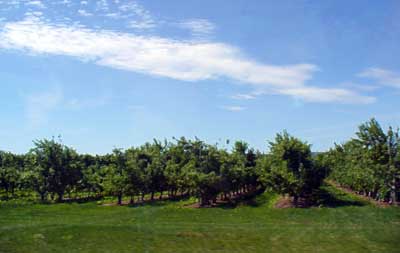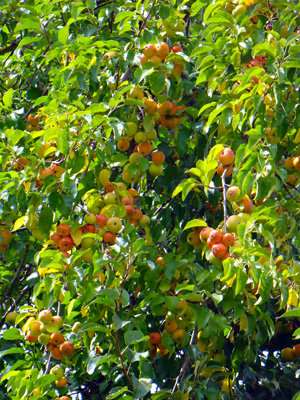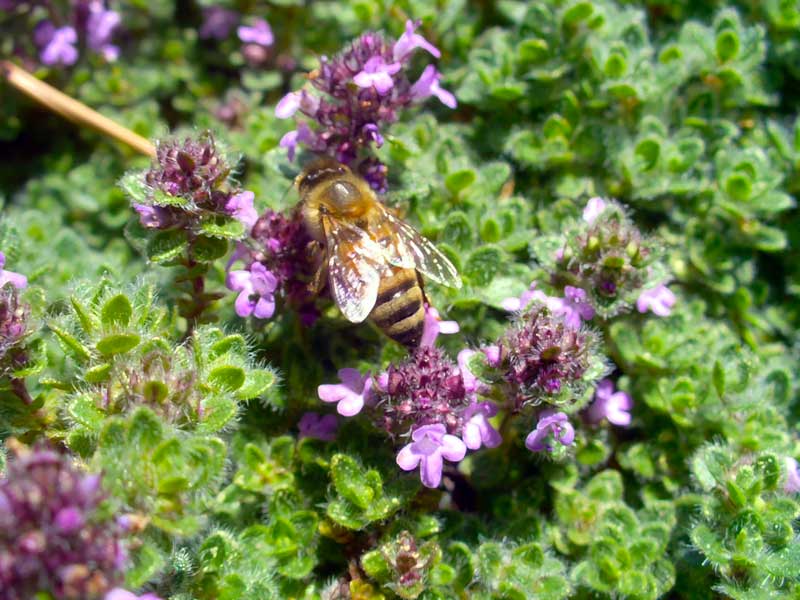How to Tell if You Have Fructose Malabsorption (Fructose Intolerance)
Do you suffer from cramping, gas and diarrhea after eating? If you have a sensitive or touchy digestive system you may have fructose malabsorption. Fructose is a sugar found in table sugar, sodas, high fructose corn syrup, fruit, honey and other sweet foods. Fructose is added to most 'sweet treats' and refined carbohydrates.
 Picture: Fruit trees grow in pretty rows in western Washington.
Picture: Fruit trees grow in pretty rows in western Washington.
If you have fructose malabsorption the body is unable to fully absorb the fructose you eat in the intestine. Since the sugar is not absorbed, gut bacteria ferment it producing short-chain fatty acids, carbon dioxide, trace gases, and hydrogen.
What are the symptoms of fructose intolerance?
Symptoms of fructose intolerance are the same as lactose intolerance or irritable bowel syndrome. The stomach clenching and gut retching symptoms include diarrhea, cramping, gas, bloating, mad rushes to the bathroom, bad breath (gas leaves by both ends of the digestive tract), intestinal distress and abdominal pain.
Diagnosis is confirmed with a positive hydrogen breath test: Bacteria use the fructose to make gases, including hydrogen gas, which can be detected with the hydrogen breath test. One of the limitations of this test is that some people produce methane instead of hydrogen. Methane causes the same painful symptoms but is nor detected by the test.
Picture: Wild apples are a striking orange red.
It may be better to assess how fructose containing foods effect your gastrointestinal tract by the elimination diet. By removing foods that contain fructose from your diet you can see if your digestive symptoms improve.
Hereditary Fructose Intolerance
There is another problem associated with fructose called hereditary fructose intolerance (HFI). This genetic condition is not related to fructose intolerance. HFI results from a deficiency of the hepatic enzyme aldolase B. This serious condition must be treated from childhood with a diet devoid of fructose.
What Causes Fructose Malabsorption?
There are several theories about what causes fructose malabsorption.
1) People with fructose malabsorption don't have enough GLUT5 and/or GLUT2 fructose carriers to take up fructose from the intestine. This leaves more fructose in the gut where bacteria can feast on it. This theory may not be true, however, one recent study showed that people with fructose malabsorption had just as many GLUT receptors as people without fructose malabsorption (Wilder-Smith et al. 2013).
2) People with fructose malabsorption may be more sensitive to the effects of an overload of fructose than other people. This may be due to intestinal bacterial populations. Susceptible people may harbor more bacteria that ferment fructose and produce noxious gases. FYI: Everyone has different populations of intestinal bacteria!
Most people with fructose malabsorption cannot consume more than 25 grams of fructose. This includes more people than you think. Clinical studies suggest that about 50% of people cannot absorb 25 grams or more of pure fructose at one time and 80% of people cannot absorb 50 grams or more of pure fructose at one time (Beyer et al. 2005, Gibson et al. 2007, Braden 2009). Another study determined that about 70% of the men tested had fructose malabsorption (Ledochowski et al. 2001).
The extra fructose sits around in the intestine 1) providing a feast for gas forming bacteria and 2) causing excess water to rush into the lower bowel to balance out the sugar and restore an osmotic balance. Sadly, excess water in the bowel plus gas usually equals explosive diarrhea.
How much do you have to eat to consume 25 grams of fructose?
One 12 oz can of most soft drinks (plus one small sip of your friend's drink!) 2 2/3 cups honey 1 1/2 cup pomegranate juice 1 3/4 cup grape juice 1 1/4 cup catsup 11 oz of dried figs About 1/4 cup sugar; the sugar molecule (sucrose) is 50% fructose and 50% glucose

Apples have one of the highest fructose contents of any fruit. To consume 25 grams of fructose you could eat:
2 cups of applesauce 2 cups unsweetened apple juice A little under a pound of raw peeled apples
As you can see, the less processed the apple the less fructose per serving.
How Does the Body take Up Fructose?
Normally, fructose is taken up passively in the intestine by fructose portal or carriers. These fructose carriers are called GLUT2 and GLUT5. With GLUT5 your body takes up fructose passively by facilitated diffusion. This process doesn't use any energy. The fructose moves into the bloodstream down its concentration gradient; since there is a lot of fructose in the intestine, some of it moves into the blood. With GLUT2, the body actively transports fructose, glucose and galactose (Gibson et al. 2007).
Glucose can help facilitate fructose upload (Jones et al. 2011). The ideal concentration is 1:1 fructose to glucose (Truswell et al. 1988). This is the ratio in table sugar. Sugar or sucrose is made of two simple sugars (glucose and fructose).
Warning: Combining fructose with sugar alcohols can create an epic explosion of gastronomical distress. Kim et al. (2011) found that combining 50 grams fructose with 33.3 grams erythritol (a non caloric sugar alcohol used in sweetenings) increased volunteers' diarrhea and gastronomical distress when compared to consuming 50 grams of fructose or 50 grams of fructose combined with 50 grams of glucose. Moral of the story: don't take candy from scientists.
Where Does Dietary Fructose Come From?
Until recently humans consumed an average of 16-24 grams of fructose each day (Douard and Ferraris 2008). Most of that fructose was in the form of fruits and honey. The average American now consumes 49 grams of fructose daily with young adults consuming an average of 75 g fructose a day (Marriott et al. 2009). Almost all of that fructose is from refined or processed fructose (Gross et al. 2004).

Picture: Honey has less fructose than table sugar.
Odd fact:
Fructose malabsorption is associated with early signs of mental depression (Ledochowski et al. 1998). Free floating fructose can interfere with tryptophan metabolism (Ledochowski et al. 2001). This reduces concentrations of tryptophan, an amino acid, which can influence mood.
Low concentrations of tryptophan may cause depression and sleeplessness. This is because tryptophan is needed to make serotonin, a mood regulator and neurotransmitter. Serotonin regulates mood, improves sleep, enhances memory and facilitates learning. Melatonin, which regulates sleep duration, is also derived from tryptophan.
Eight Ways to Control Fructose Malabsorption
- Eat less fructose. Studies have shown that adhering to a low fructose diet can improve or eliminate gastrointestinal symptoms caused by fructose sensitivities (Johlin et al. 2004, Shepherd et al. 2006).
- Avoid high fructose sweeteners like high fructose corn syrup, pancake syrup, fruit juices, honey, molasses and agave syrup. You can substitute safer sweeteners like lactose, dextrose (different name for glucose), pure glucose, maltose and table sugar (sucrose) in small amounts.
- Eat foods with fructose as part of a meal. This includes high fructose fruits such as figs, dates, prunes, pears, persimmons, grapes and mangos. Always avoid fruit juices which are very high in fructose.
- Don't combine fructose with sugar free products containing sugar alcohols such as erythritol or sucralose. Fructose + sugar alcohols = much more time spent in rest room.
- Spread out any fructose you do eat over the whole day to help prevent a large overload.
- Avoid 64 oz Big Double Cups of Cola (or any soda)! There are around 190 grams of sugar in a 64 oz soda (which means you have between 95 - 128 grams of fructose depending on which type of sugar or high fructose corn syrup is used as sweetener). This is about 50 teaspoons of sugar! Some people find that they can eliminate their symptom just from cutting out fructose laden drinks like sodas and fruit juices.
- Try unsweetened full fat versions of your favorite dairy products. Watch for added fructose.
- Some people have had great success by adopting a diet very low in sugars and carbohydrates such as the Paleo diet.
Warning: recent independent tests have shown that the amount of fructose is under reported on most soft drinks. This is because some of them use high fructose corn syrup with a higher percentage of fructose than is calculated on the nutritional label (high fructose corn syrup can have from 55%-85% fructose).
Unpleasant Side Effect of Cola Drinking: There is a reason you burp so much when you drink soda - not all of that gaseous emission is due to soft drink carbonation. I had friend who was proud of her ability to out burp any guy. She accused me of being too delicate to burp in public. I told her I didn't need to burp since I didn't drink soda. She didn't believe me until she cut out her 3-5 can of cola addiction for New Years. To her surprise, her ability to burp her name to impress random 12 year old boys disappeared. All that excess fructose consumption from soft drinks causes hydrogen and methane gas production in the gut which can go out of only two exits. And you don't get to pick which way it goes.
References:
Beyer PL, Caviar EM, McCallum RW. Fructose intake at current levels in the United States may cause gastrointestinal distress in normal adults. J Am Diet Assoc. 2005;105:1559-66. Pubmed. Braden B. Review Methods and functions: Breath tests. Best Pract Res Clin Gastroenterol. 2009;23:337-52. Pubmed. Douard V and Ferraris RP. Regulation of the fructose transporter GLUT5 in health and disease. Am J Physiol Endocrinol Metab. 2008; 295: E227–E237. Pubmed. doi: 10.1152/ajpendo.90245.2008 (full paper) Gibson PR, Newnham E, Barrett JS, Shepherd SJ, Muir JG Aliment Pharmacol Ther. Review article: fructose malabsorption and the bigger picture. 2007;25:349-63. Pubmed. Full text. Gross LS, Li L, Ford ES, Liu S. Increased consumption of refined carbohydrates and the epidemic of type 2 diabetes in the United States: an ecologic assessment. Am J Clin Nutr. 2004;79:774–779. Pubmed. Full text. Johlin FC Jr, Panther M, Kraft N. Dietary fructose intolerance: diet modification can impact self-rated health and symptom control. Nutr Clin Care. 2004;7:92-7. Pubmed. Jones HF, Butler RN, Brooks DA. Review: Intestinal fructose transport and malabsorption in humans. Am J Physiol Gastrointest Liver Physiol. 2011 Feb; 300(2):G202-6. Pubmed. doi: 10.1152/ajpgi.00457.2010 (full paper) Kim Y, Park SC, Wolf BW, Hertzler SR. Combination of erythritol and fructose increases gastrointestinal symptoms in healthy adults. Nutr Res. 2011;31:836-41. Pubmed. doi: 10.1016/j.nutres.2011.09.025 Ledochowski M, Sperner-Unterweger B, Widner B, Fuchs D. Fructose malabsorption is associated with early signs of mental depression. Eur J Med Res. 1998;3:295-8. Pubmed. Ledochowski M, Widner B, Murr C, Sperner-Unterweger B, Fuchs D. Fructose Malabsorption is Associated with Decreased Plasma Tryptophan. Scand J Gastroenterol. 2001;36:367-71. Pubmed. Marriott BP, Cole N, Lee EJ. National estimates of dietary fructose intake increased from 1977 to 2004 in the United States. Nutr. 2009;139:1228S-1235S. Pubmed. doi: 10.3945/jn.108.098277 (full text)
Shepherd SJ and Gibson PR. Fructose Malabsorption and Symptoms of Irritable Bowel Syndrome: Guidelines for Effective Dietary Management. J Am Diet Assoc. 2006;106:1631-1639. Pubmed. Truswell AS, Seach JM, Thorburn AW. Incomplete absorption of pure fructose in healthy subjects and the facilitating effect of glucose. Am J Clin Nutr. 1988;48:1424-30. Rutledge AC, Adeli K. Fructose and the metabolic syndrome: pathophysiology and molecular mechanisms. Nutr Rev. 2007;65:S13–23. Pubmed. Full text. Wilder-Smith CH, Li X, Ho SSY, Leong SM, Wong RK, Koay ESC, Ferraris RP. Fructose transporters GLUT5 and GLUT2 expression in adult patients with fructose intolerance. United European Gastroenterology Journal 2013. DOI: 10.1177/2050640613505279
